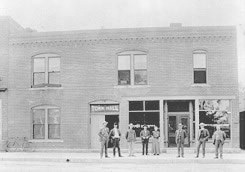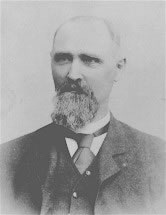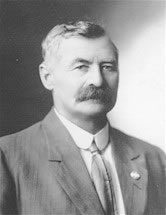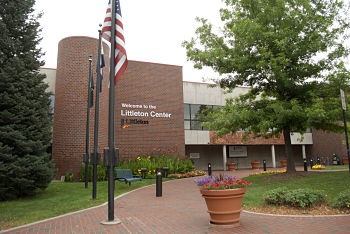Government of Littleton from the Time of Incorporation
Those who were interested in incorporation for Littleton began to get serious in 1889 when Joseph Bowles and other landowners west of the Platte River moved to incorporate the town of Wynetka to avoid Littleton taxes. The race was on to see who could take in the lands across the river first. Sheridan was consolidating just to the north, and there was always the threat of Denver "casting its influences about us." Both Wynetka and Littleton filed papers the same day, 1 October 1889. Wynetka won because Littleton's papers were faulty and had to be resubmitted.

First Town Hall and Arapahoe County offices, 1904.
Finally, on 8 March 1890, Littleton citizens were ready for the vote. Incorporation passed with only three votes dissenting. Further elections on 1 April yielded a mayor, F. S. Gilmore, and trustees J. D. Hill, Harry Knight, A. M. Bair, F. W. Shuckhart, Dr. W. S. Weaver, and John G. Lilley. (Wynetka lasted slightly more than two years and was discontinued.)


Mayors Franklin S. Gilmore (1890-1891) and John B. Mayers (1912-1913).
Editor Emeritus Houstoun Waring (probably relating accounts by Ed Bemis) said that the early town board met upstairs in the J. D. Hill general store on Rapp Street and also in a frame building on Malinda (now Alamo) Street where volunteer firemen kept their equipment. Then they rented rooms in the back of the large building at 2450 West Main which L. Evans had erected in 1889 for his bakery. On 10 September 1898, the city bought "Evans Hall," and made it the official town hall. The site was the same as that used in 1920 for the town hall designed by Jacques Benedict. In 1997 the Benedict building is the Town Hall Arts Center.
Evans Hall sat far back from the sidewalk. After Arapahoe County was divided in 1902, the town board built a brick front on the building and rented the new space to "South Arapahoe County" officials. (Waring said that in 1905 the Lilley Block was built at 2519 West Main and it was used for the county courthouse until the new one was built at the east end of Main Street in 1908.)
From 1890 to 1959, Littleton was a statutory city governed by the Colorado State Legislature. On 28 July 1959 the city charter election was approved, and it became a home-rule city. This meant a change to a city manager style government with seven elected councilmen. Four of these are from legislative districts, and three are elected at large. The council is directly responsible to the people, and, as the community's legislative body, it sets policy, approves budgets, and determines tax rates.
In 2020, Littleton voters approved an amendment to the city charter which, starting in 2021, allows voters to directly elect the mayor. (Previously, the mayor was elected by council every two years from among the seated members.)

Littleton Center, 2015. Photo by Amelia Martinez.
The city manager is a professional administrator appointed by council to manage city business. He serves as council's chief advisor, recruits and hires employees, recommends the budget for council's action, and sees that council policies and programs are carried out.
The city used the Benedict town hall at 2450 West Main for fifty-seven years, until the new Littleton Center was built at 2255 West Berry in 1977. The site was fifteen-acre Geneva Village which had been purchased in 1975 after voters approved a bond election. Architect was Muchow Associates of Denver. Robert G. Fisher was contractor. The city made its final payment on 1 July 1986. The complex includes general administrative offices, the police department, a communications department, and public meeting rooms. The Littleton Council Chamber was extensively renovated in 2020.
Mayors of Littleton 1890-Present
1890-91 Franklin S. Gilmore
1891-92 Dr. D.S. Weaver
1892-93 H.H. Shepperd
1893-94 H. Vannatta
1894-95 G.M. Benedict
1895-96 H.H. Shepperd
1896-97 G.M. Benedict
1897-98 C.H. Barclay
1898-01 H.H. Shepperd
1901-02 C.W. Sittser
1902-05 Dr. J.A. Farnsworth
1905-06 R.F. Gill
1906-08 H.H. Shepperd
1908-10 Dr. W.C. Crysler
1910-12 J.E. Maloney
1912-13 John B. Mayers
1913-19 J.E. Maloney
1919-21 S.A. Noyes
1921-24 O.C. Hoffman
1924-26 Dr. W.C. Crysler
1926-29 C.E. Stephenson
1929-32 Charles G. Louthan
1932-34 Dr. C.C. Harrod
1934-41 Charles G. Louthan
1941-46 H.H. Taylor
1946-48 Roy E. Babcock
1948-52 George Malcolm
1952-56 Norman Granes
1956-57 Frank A. Randall
1957-59 A.N. (Bert) Williams
1959-60 Everett Dawson
196o-63 Gordon F. Taylor
1963-65 Thomas R. Heaton
1965-69 John G. Kinghorn
1969-71 A.R. Bessette
1971-75 F. Vaughn Gardinier
1975-77 Harold Meyer
1977-79 Sally M. Parsons
1979-83 James P. Collins
1983-89 Charley Emley
1989-93 Susan Thornton
1993-97 Dennis Reynolds
1997-99 Pat Cronenberger
1999-2003 Susan Thornton
2003-05 John Ostermiller
2005-07 Jim Taylor
2007-11 Doug Clark
2011-13 Debbie Brinkman
2013-2015 Phil Cernanec
2015-2017 Bruce Beckman
2017-2019 Debbie Brinkman
2019-2021 Jerry Valdes
2021-Present Kyle Schlachter
Bibliography
Keller, Carolyn. "Joseph W. Bowles. 1835-1906." Research paper prepared for Littleton Historical Museum. Denver, Colo.: University of Colorado at Denver, 1989.
Littleton (Colo.) Independent. Littleton, Colo.: Littleton Independent Publishers, 1888- .
Littleton Museum. Photographic Archives.
____. Vertical Files: "Littleton City Government--General and Town Growth."
McQuarie, Robert J. and C. W. Buchholtz. Littleton, Colorado. Settlement To Centennial. Littleton, Colo.: Littleton Historical Museum and Friends of the Littleton Library and Museum, 1990.
Photographs courtesy of the Littleton Museum unless otherwise noted. To order copies, contact the museum at 303-795-3950.
Compiled by Doris Farmer Hulse
Updated December 2021 by Phyllis Larison